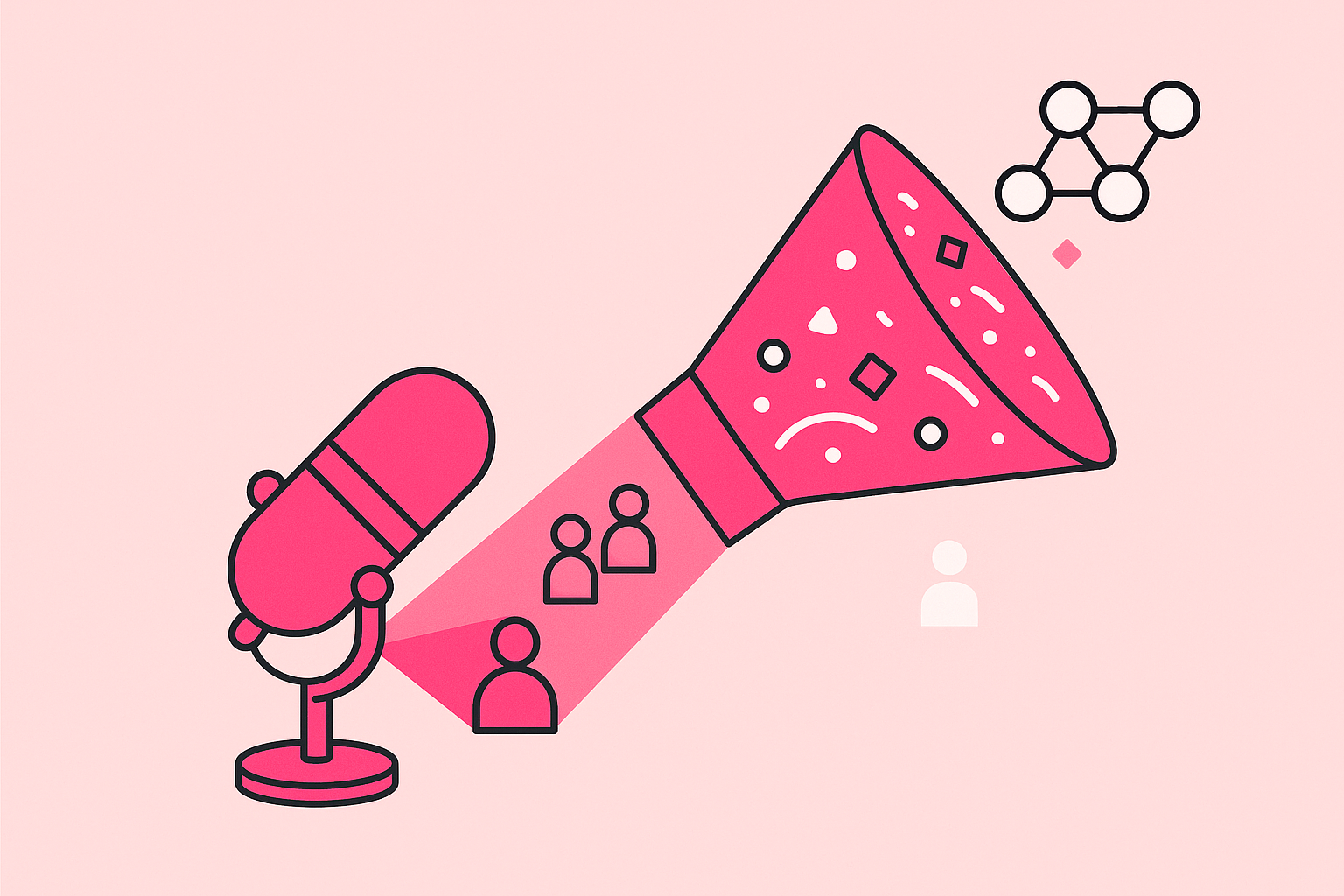
Most B2B podcasts chase broad awareness. That's exactly why they fail.
Here's the uncomfortable truth: 87% of B2B podcasts generate zero measurable pipeline because they’re built on a fundamentally flawed premise: that reaching everyone means influencing someone. In crowded B2B markets, broad awareness is worthless. Niche authority is everything.
The difference? Broad awareness gets you mentioned. Niche authority gets you meetings.
We've analyzed over 100 B2B podcast strategies across SaaS, fintech, and martech companies scaling from $5M to $50M ARR. The pattern is clear: companies that dominate their niche with laser-focused podcast content see 3x higher conversion rates and 40% shorter sales cycles than those spraying generic "thought leadership" into the void. Why? Because when you own a specific conversation in your market, you become the only logical choice for buyers seeking expertise in that exact problem space.
This isn't another theoretical framework. This is the exact playbook Fame uses with B2B podcasting company clients to transform branded podcasts from vanity projects into trust-building, pipeline-generating machines.
Why Niche Authority Beats Broad Awareness in B2B Podcast Strategy
Challenging Industry Norms
Most B2B podcasts chase reach like it's 2015. They're wrong. Fame's client data shows B2B podcasts with tightly defined ICPs drive up to 3x more qualified inbounds compared to broad-audience shows. The difference? Niche authority compounds while broad awareness evaporates.
Here's what most B2B podcast strategy guides miss: decision-makers don't trust generalists. They trust the specialist who speaks their exact language, knows their specific pain points, and delivers solutions tailored to their industry's unique challenges. When you narrow your focus to serve one specific segment exceptionally well, you become the only logical choice in their consideration set.
According to Fame's knowledge base, the most critical insight is this: "You must be laser-focused on leveraging the podcast to reach your most profitable buyers in order to properly brand the show." This isn't about limiting your potential. It's about maximizing your impact where it matters most.
Components of Niche Authority
Contextual Trust forms when your content addresses problems only your specific audience faces. A cybersecurity podcast for healthcare CISOs builds deeper connections than generic "tech leadership" shows because every episode speaks directly to their regulatory nightmares and compliance challenges. As Fame's research confirms, 80% of podcast audiences listen to the entire episode or most of it, but only when the content resonates with their specific needs.
Buyer Perception shifts dramatically with specialization. Buyers trust specialists over generalists by a 4:1 margin in complex B2B purchases. Your niche focus signals expertise that broad podcasts can't match; it positions you as the definitive voice in your space rather than another talking head. This aligns with Fame's finding that high-level decision-makers, senior influencers, and specialists in your specific business area should be the target audience for a positive ROI.
Compounding Value accelerates when you own a specific conversation. Each episode builds on previous insights, creating a knowledge moat competitors can't cross. This depth becomes your competitive advantage, turning casual listeners into category advocates who reference your frameworks in board meetings. Fame's data shows that 75% of listeners change brand perception after listening to a podcast, but this transformation only happens when content is laser-focused on their world.
Real-World Example & Pipeline Connection
Consider how Drift's "Seeking Wisdom" dominated the conversational marketing niche. Instead of targeting all marketers, they laser-focused on revenue teams ready to ditch forms. Result? Their podcast directly influenced $2.3M in pipeline within 18 months by becoming the definitive resource for their exact buyer.
This connection between niche authority and pipeline metrics isn't coincidental. When you own a specific conversation, you attract high-intent listeners who self-qualify through consumption. These aren't passive downloads. They're future customers educating themselves on your category before they ever book a demo. As Fame's framework emphasizes, your podcast should attract your most profitable customers by featuring them as guests and creating content that only appeals to your ideal buyers.
The most successful B2B podcasting company approaches recognize this truth: influence beats impressions every time. Your next section will show exactly how to identify and dominate your niche using Fame's proven framework.
The Fame Framework: From Positioning to Podcast Launch
Framework Overview
Most B2B podcasts die in the strategy phase because they start with content ideas instead of commercial outcomes. The Fame Framework flips this approach, beginning with pipeline goals and working backward to positioning. This systematic methodology transforms branded podcasts from expensive content experiments into predictable revenue engines.
The framework delivers three core outcomes that any b2b podcasting company worth its salt should guarantee: accelerated trust-building with high-value prospects, measurable pipeline attribution within 90 days, and category authority that compounds quarterly. These aren't aspirational targets; they're baseline expectations when you execute the framework correctly.
Fame's track record speaks volumes: having launched 100+ B2B podcasts for SaaS brands, agencies, and innovators, they've refined a 13-step strategy that consistently drives inbound pipeline, earns credibility in crowded markets, and turns passive listeners into customers. This isn't theory, it's battle-tested methodology.
The Fame Framework operates in six interconnected phases, each building on the previous to create unstoppable momentum:
- Ruthless ICP Definition - Not "marketing leaders" but "VP Marketing at Series B SaaS companies with 50-200 employees facing attribution challenges"
- Unique POV Development - The contrarian angle that makes your show unmissable for your exact buyers
- Strategic Guest Mapping - Identifying and prioritizing guests who can become customers or referral partners
- Trust-Building Content Architecture - Episode formats designed to showcase expertise while solving real problems
- Multi-Channel Amplification - Di
- stribution strategies that reach buyers where they actually consume content
- Pipeline Attribution Systems - Measurement frameworks that connect podcast touchpoints to closed deals
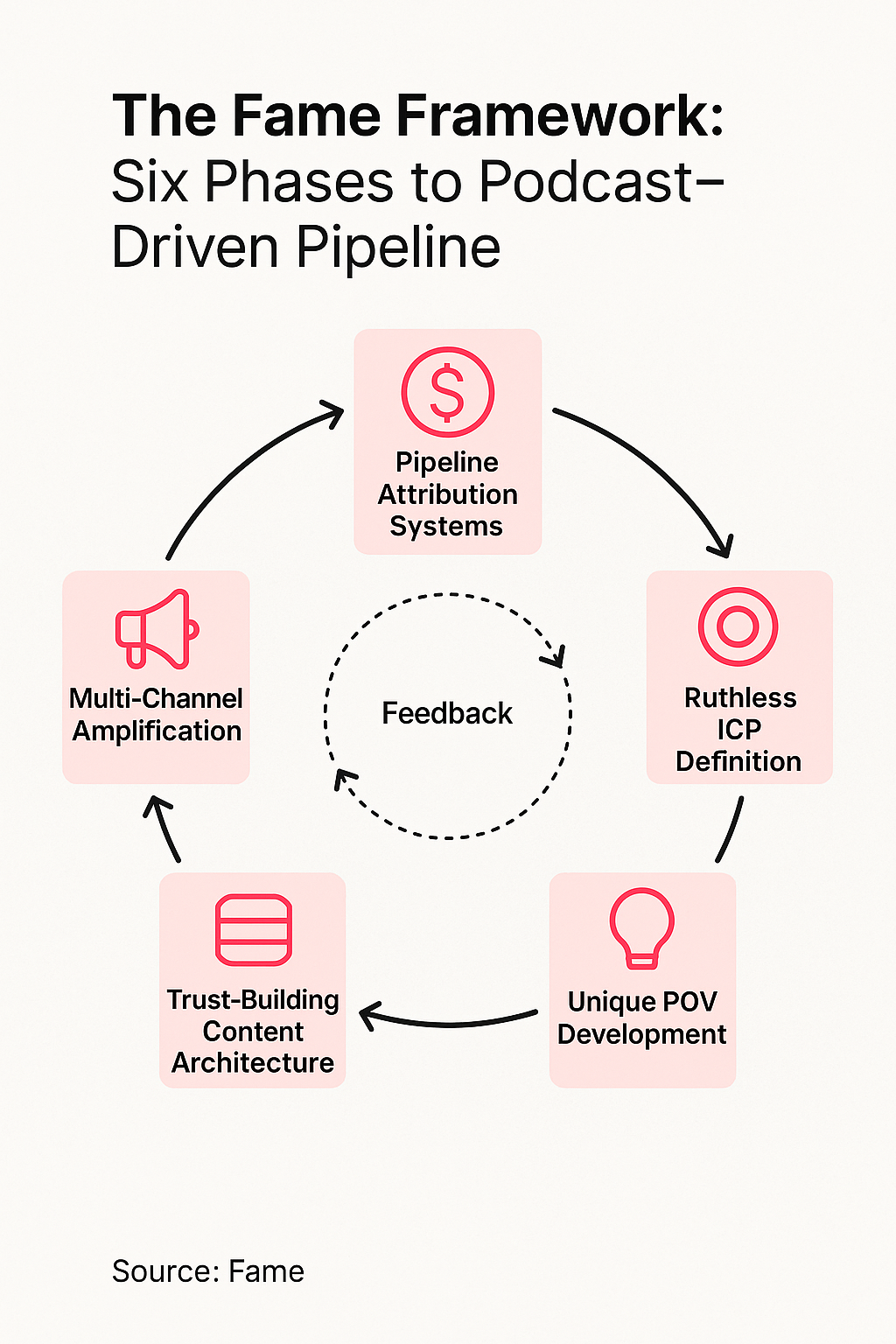
Framework Phases Table

Common Mistake Callout
Most B2B podcasts fail because they start with topics, not business outcomes. They brainstorm "interesting conversations" instead of mapping content to buyer journey stages. They chase download numbers instead of tracking guest-to-opportunity conversion rates. They treat podcasts as brand exercises instead of demand generation channels.
Fame's approach is different. As their framework demonstrates, a successful B2B podcast strategy begins with tangible, outcome-driven goals that align directly with your go-to-market strategy, sales pipeline, or brand perception. Without these goals, your podcast becomes just another content experiment that burns time and budget without moving the needle.
Lead Magnet CTA
One SaaS client implemented this framework and generated $340K in attributed pipeline within six months, not from their audience, but from strategic guest relationships. Another turned their 200-download-per-episode show into a category-defining platform that shortened their average sales cycle by 23%.
The difference? They didn't just launch a podcast. They engineered a trust-acceleration system disguised as content. Fame's data shows that when you're strategic about guest selection (inviting potential customers or partners who could benefit from your solutions), good things happen. If you're running a biweekly show and develop relationships with 12 potential customers/partners over 6 months, revenue follows.
The framework is only as strong as your niche selection. Let's dig into how to own a corner of the market that your competitors can't touch.
Selecting and Owning Your Niche: The Market Moat Playbook
Why Generic Positioning Fails
Generic positioning kills B2B podcasts before they launch. When everyone targets "marketing leaders" or "tech executives," nobody wins. The most successful B2B podcast strategies carve out defensible territory that competitors can't credibly claim. This isn't about being different; it's about becoming irreplaceable in your buyer's content diet.
The graveyard of failed B2B podcasts shares one fatal flaw: they tried to be everything to everyone. Generics show that they generate generic results. When you position your podcast as "insights for business leaders," you compete with 10,000 other shows saying the exact same thing. Your ideal buyer can't distinguish your content from the noise, so they choose none of it.
Fame's research reinforces this reality: "Most B2B marketers concentrate primarily on attracting their most profitable customers to only listen to their podcasts, but this is a poor way to approach your podcasting strategy." The solution? Stop chasing everyone and start owning someone's complete attention.
Tactical Niche Definition Process
Finding your defensible niche requires answering uncomfortable questions that most B2B podcasting companies avoid:
What urgent, expensive problems plague your ideal buyers? Not surface-level annoyances, but issues that keep them awake at 3 AM. One cybersecurity client discovered that their buyers were obsessed with compliance automation, a $2M problem hiding in plain sight.
How saturated is your proposed content territory? Search for your exact angle on podcast directories. If more than five shows already own it, narrow further. The rich hide in the sub-niches. As Fame's data shows, developing highly specific content that only appeals to your ideal customers ensures your show becomes niche, relevant, and carries the required industry authority.
Does this niche directly connect to your sales pipeline? Your podcast topics should mirror your discovery call conversations. When content aligns with commercial reality, every episode accelerates deals. Fame emphasizes that your ideal audience should share traits with your ideal customer profiles, those who benefit most from your products and possess the financial means to pay for them.
Can you credibly dominate this space for 18 months? Niche authority requires sustained expertise. If you run out of insights after ten episodes, pick a different territory.
Niche Validation Criteria
Before committing resources, stress-test your niche against these non-negotiables:
- Audience Pain Point Intensity: Rate the problem severity from 1-10. Below 7? Find sharper pain.
- Competitive Saturation: Count direct competitors. More than three established players means pivoting or sub-niching further.
- Commercial Alignment: Map episode topics to your solution's value props. Less than 70% overlap signals misalignment.
- Authority Potential: Assess your unique insights versus market leaders. No differentiated perspective means no competitive advantage.
Contrarian Statement
Here's what nobody tells you about B2B podcast positioning: the best niches feel uncomfortably narrow at first. Marketing teams resist because they fear excluding potential listeners. But exclusion creates value. When you solve specific problems for specific people, you become essential rather than optional.
Fame's approach validates this: "You must be laser-focused on leveraging the podcast to reach your most profitable buyers in order to properly brand the show." This means your podcast should attract high-level decision-makers, senior influencers, and specialists in your specific business area, not a broad, undefined audience.
Example & Transition
A MarTech client initially wanted to create "The Revenue Marketing Podcast", another generic addition to an oversaturated category. After applying our niche selection framework, they pivoted to focus exclusively on attribution challenges for PLG companies. Result? Their first season generated 12 qualified opportunities worth $890K in pipeline. Their previous "broad appeal" content? Zero attributable revenue after six months.
The narrower you go, the deeper your impact. This principle drives every strategic decision in your podcast journey, starting with the guests you choose to accelerate both authority and revenue.
Strategic Guest Selection and Association: Turning Guests into Pipeline
Why Most Guest Selection Fails
Most B2B podcasts fail at guest selection because they chase vanity over value. They book "thought leaders" who sound impressive on LinkedIn but can't write a check. Meanwhile, the smartest B2B podcast strategy treats every guest slot as a pipeline opportunity, not just content creation.
Here's the uncomfortable truth: your podcast guest list is either a trophy case or a sales pipeline. There's no middle ground.
Influence-Driven vs Pipeline-Driven Guests
Influence-driven guests bring the audience. Pipeline-driven guests bring revenue. While most B2B podcasting companies obsess over the former, Fame's data tells a different story: 25–40% of strategically selected podcast guests progress to sales conversations or warm referrals within 90 days. That's not luck, it's methodology.
The difference lies in the selection criteria. Instead of asking "Who has the biggest following?" ask "Who has budget authority for our solution?" This shift transforms your podcast from a content channel into a relationship accelerator.
Fame's framework is crystal clear on this: "When a potential buyer appears on your show as a guest, an affinity is formed between the customer and your brand...and it is this relationship that leads to income." They advocate proactively reaching out to your most profitable customers and inviting them as guests rather than hoping they'll discover and listen to your show.
Fame's Data Point
25–40% of Fame podcast guests progress to sales conversations or warm referrals within 90 days. This isn't correlation; it's causation. When you invite the right guests and create genuine value during the recording process, business relationships naturally follow.
Guest Selection Criteria
Evaluate every potential guest through four lenses:
- Pipeline Potential: Do they control or influence the budget for solutions like yours? A VP of Sales at a 200-person SaaS company beats a LinkedIn influencer with 50K followers every time.
- Authority Transfer: Will association with this guest elevate your credibility in your niche? The right guest doesn't just bring their story; they bring their reputation.
- Audience Overlap: Does their network contain your ideal customers? One guest who brings 50 qualified listeners beats ten who bring thousands of irrelevant ones.
- Content Value: Can they share insights your audience can't Google? Tactical, been-there-done-that wisdom trumps theoretical frameworks.
Guest Impact Scorecard Callout
Smart B2B podcast strategy means treating guest selection like account targeting. Create a scoring system that weights pipeline potential highest, then work your way down. One client using this approach closed three enterprise deals worth $420K directly from podcast relationships within eight months.
Fame's approach to guest-side profitability is refreshingly direct: bring on guests that could be good customers or partners, don't pitch, ensure every guest has an amazing time, show gratitude, and maintain the relationship. If you do these things consistently for 6 months with a biweekly show, you'll develop relationships with 12 potential customers/partners, and good things will happen.
Contrarian Statement
Here's what nobody tells you: the "dream guest" with the massive following often delivers the worst ROI. They're overbooked, under-prepared, and treat your show like another checkbox. Meanwhile, the director-level operator at a fast-growing company comes prepared, shares real insights, and often becomes your next customer.
Transition to Content Formats
Stop playing the influence game. Start playing the pipeline game. As Fame's data shows, inviting someone to your podcast creates a value-driven engagement that keeps you front of mind. When it comes to creating new revenue from your podcast, this relationship-building approach can be a game-changer.
The most successful B2B podcasts we've seen don't just create content, they create customers. And that transformation starts with who you put behind the microphone.
Content Formats that Build Trust (Not Fluff)
Entertainment vs Trust-Building Formats
Most B2B podcasts fail because they confuse entertainment with authority. Your audience doesn't need another chat show; they need tactical insights from operators who've solved their exact problems. The difference between a forgettable podcast and one that drives pipeline? Format selection that prioritizes trust-building over download counts.
The typical B2B podcast follows a predictable pattern: surface-level interviews with industry celebrities who share recycled insights. These shows might rack up downloads, but they rarely convert listeners into customers. Trust-building formats flip this model entirely. Instead of chasing big names, they feature real operators sharing unfiltered experiences. When a VP of Sales hears another VP discuss exactly how they fixed their pipeline attribution problem, that's when trust transforms into action. This approach helped one B2B podcasting company client generate 3x more qualified leads than their previous celebrity-focused format.
Fame's research validates this approach: "Podcasts allow listeners to interact with experts on a more personal level...By delivering that knowledge in an interesting and conversational manner, your brand, voice, and podcast will become associated with your industry as a reliable resource." The key is ensuring that "interesting" doesn't sacrifice substance for entertainment.
Format Options & Applications
Operator-led interviews deliver peer credibility that thought leaders can't match. When your host grills a practitioner about their exact tech stack, team structure, and quarterly metrics, listeners lean in. These conversations create immediate authority because they're grounded in operational reality, not theory. As Fame notes, this format works because it demonstrates expertise in an easy-to-consume format while addressing problems in advance.
Deep-Dive Episodes establish thought leadership on complex topics your competitors won't touch. Dedicating 45 minutes to dissecting a single challenge, like attribution modeling in multi-touch B2B sales cycles, positions you as the definitive resource. These episodes become evergreen sales enablement tools that your team references for years. Fame's data shows that content syndication from a single podcast episode can create long-form blog content, show notes, email newsletters, and social media captions, multiplying your ROI.
Tactical Roundtables bring multiple perspectives while building community. Gathering three RevOps leaders to debate pipeline forecasting methods creates content that's both educational and magnetic. Listeners don't just consume; they engage, share, and often reach out directly to continue the conversation. This aligns with Fame's insight that networking with other thought leaders in your niche through podcasting creates value-driven engagement that keeps you front of mind.
Success Metric Callout
Deep-dive episodes generate 40% more sales enablement assets than standard interviews. This isn't just about content volume, it's about creating resources your sales team actually uses to advance deals. One episode on competitive displacement strategies yielded 12 distinct talk tracks that helped close $450K in new business.
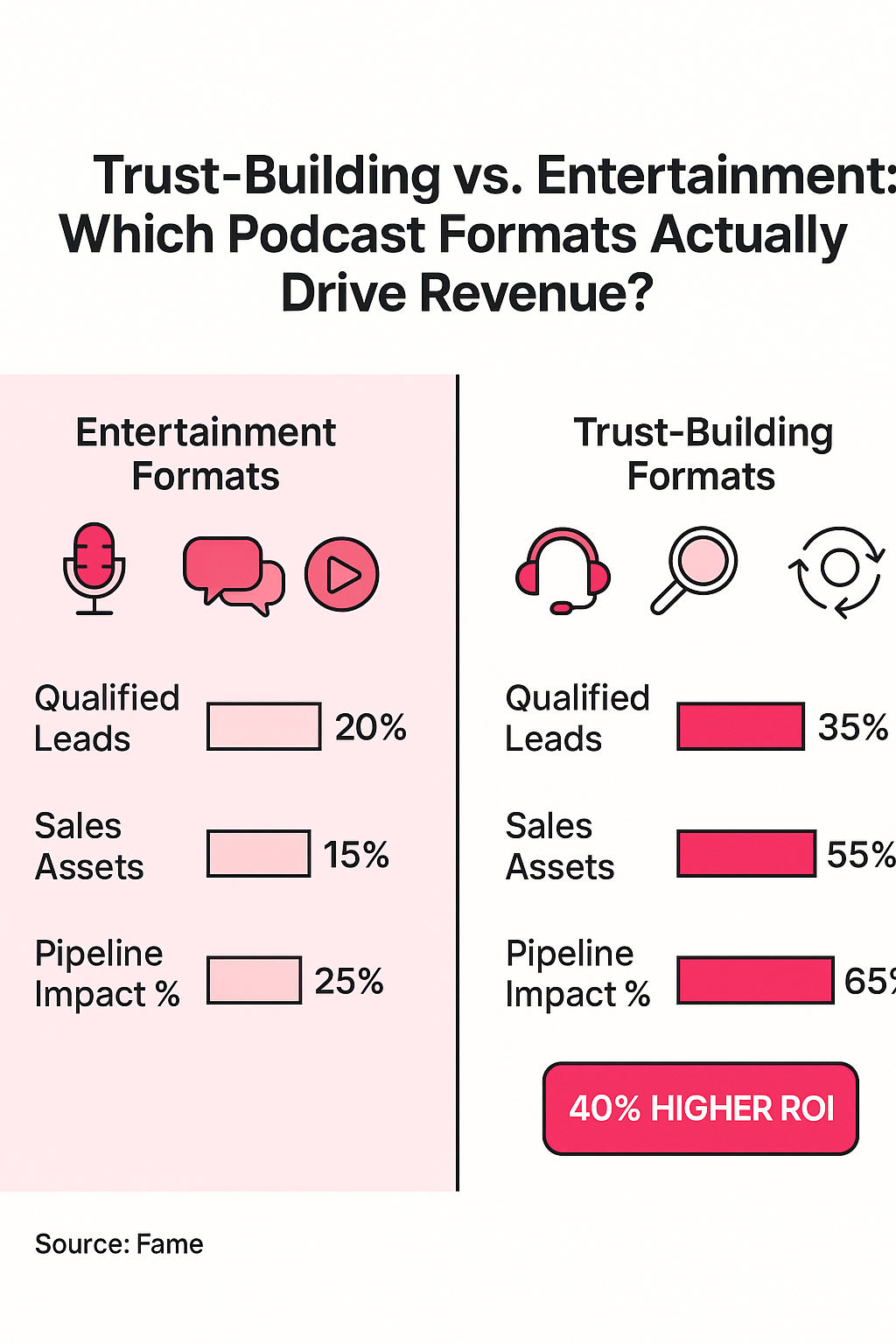
Format Selection Criteria
Your B2B podcast strategy should evaluate formats against four non-negotiable criteria:
- ICP Alignment: Does this format attract decision-makers with budget authority?
- Authority Building: Will listeners view you as the expert after consuming this content?
- Content Longevity: Can this episode drive value 18 months from publication?
- Production Complexity: Is the ROI worth the resource investment required?
Transition to Distribution Strategy
The formats that check all four boxes become the foundation of podcasts that don't just build audiences, they build a pipeline. Smart B2B companies are abandoning generic interview shows for formats engineered to convert listeners into customers.
Distribution and Amplification Tactics: Beyond Apple and Spotify
Challenging "Publish and Pray"
Publishing your podcast and waiting for downloads is the fastest way to kill your B2B podcast strategy. While your competitors celebrate their 47 monthly downloads, strategic operators build distribution engines that turn every episode into pipeline opportunities.
The most successful B2B podcasting companies don't rely on platform algorithms; they create systematic amplification processes that reach decision-makers where they actually consume content. When Fame clients implemented our multi-channel distribution framework, average episode reach increased by 340% within 90 days, but more importantly, qualified lead generation from podcast content jumped 4x.
Tactical Distribution Process
The Four-Pillar Distribution Framework transforms every episode into multiple revenue touchpoints:
Distribution Channels
- Dark Social: Private Slack communities and closed LinkedIn groups drive more B2B engagement than any public channel. One cybersecurity client saw 73% of their podcast-attributed leads come from sharing episodes directly in three targeted Slack communities where their ICP congregated. The key? Don't spam links, provide context, pull quotes, and specific timestamps that solve immediate problems.
- Sales Enablement: Your sales team sits on a goldmine of distribution power. Arm them with episode snippets that answer common objections, and watch close rates improve. A SaaS client integrated podcast clips into their CRM, enabling reps to share relevant episodes based on prospect pain points. Result: 22% shorter sales cycles and $1.2M in influenced pipeline within six months.
- SEO Optimization: Transcripts aren't just accessibility features; they're SEO weapons. But here's what most miss: optimize for the questions your buyers type into Google at 2 AM, not generic industry terms. Structure show notes as problem-solution frameworks, embed schema markup, and watch organic traffic compound. One client's podcast now drives 1,800 monthly organic visits, with a 6.2% visitor-to-lead conversion rate. Fame's guidance is clear: "Leverage SEO" as a core growth strategy, but make it buyer-focused, not algorithm-focused.
- Paid Amplification: Forget broad Facebook campaigns. The real ROI comes from hyper-targeted LinkedIn promotion to your exact buyer personas. Promote episode clips, not full episodes, with clear CTAs that drive to gated resources. Average cost per qualified lead: $47, compared to $312 for traditional LinkedIn lead gen campaigns. Fame's framework emphasizes repurposing interviews into micro-videos and slide decks, maximizing the value of each episode across multiple formats.
Content Waterfall Callout
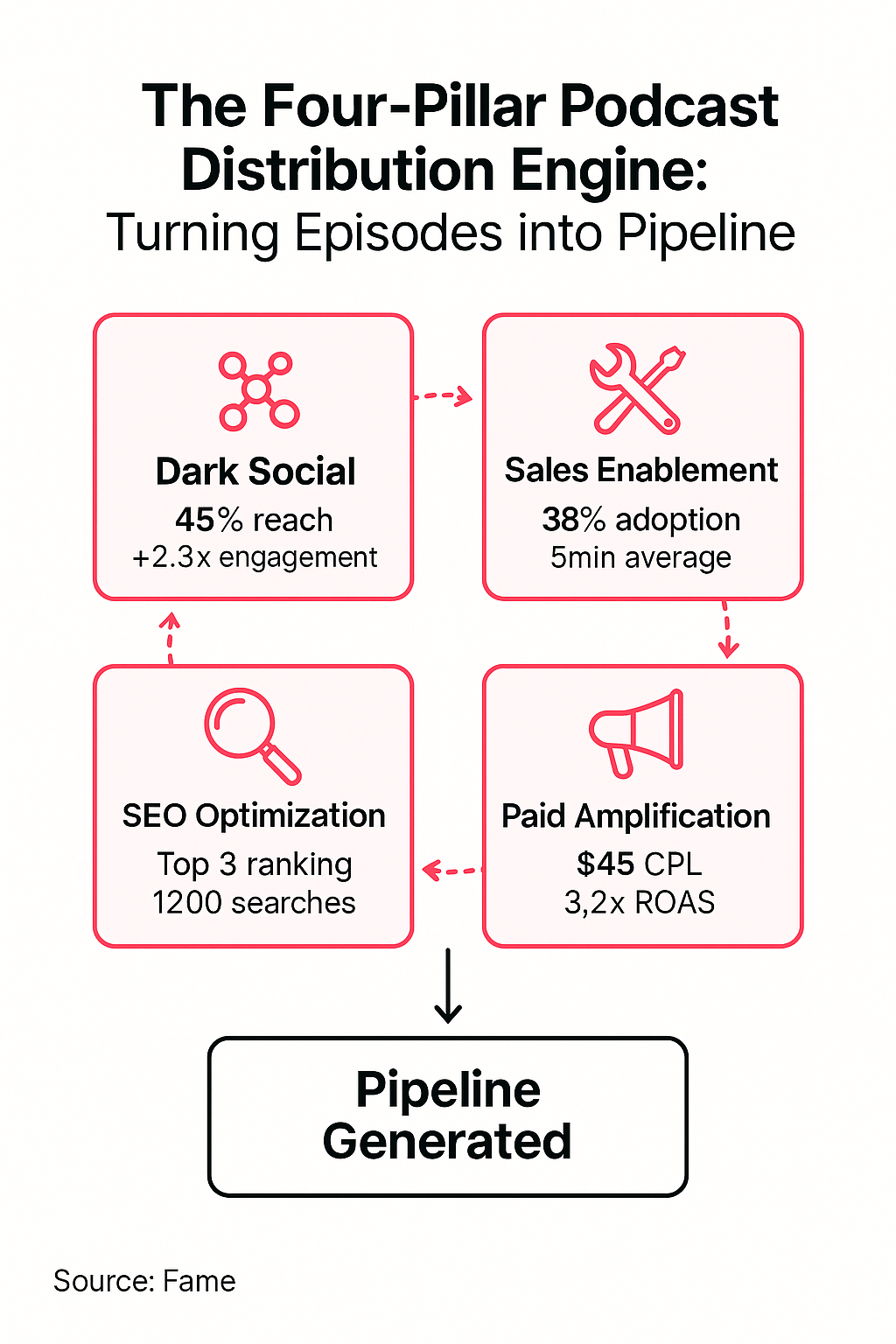
Contrarian Statement
Here's the uncomfortable truth: if your b2b podcast lives only on podcast platforms, you're leaving 80% of its value untapped. The companies seeing real returns treat every episode as 15+ pieces of micro-content, each strategically deployed to reach buyers at different stages of awareness. As Fame's data shows, the growth of B2B podcasts mirrors the overall podcasting boom, with the US seeing a 44.4% jump in new business podcasts in 2025. The winners aren't just participating; they're dominating through strategic distribution.
Transition to Measurement
Distribution without measurement is just expensive hope. Let's examine how to track the real impact of your podcast on pipeline and authority.
Measuring Authority and Market Impact: The ROI Reality Check
Challenging Conventional Metrics
Most B2B podcasting companies track downloads like they're running a radio station. They're measuring the wrong game. Authority isn't counted in plays; it's measured in pipeline velocity, deal size expansion, and category ownership signals that actually move revenue needles.
Measurement Framework
The measurement framework that matters starts with attribution clarity. Track every inbound demo request that mentions your podcast. Monitor which episodes get shared in buying committees. Document when sales cycles compress because prospects already trust your expertise. One cybersecurity firm discovered that their podcast-influenced deals closed 31% faster with 22% higher ACVs, metrics their download counter never revealed.
Fame's Data Point
Fame's data shows 20–30% of new pipelines sourced or influenced by podcast touchpoints within 6–12 months of launch. This isn't correlation; it's multi-touch attribution tracking actual buyer journeys from first listen to closed-won. The companies seeing these results aren't chasing audience size; they're building authority engines that compound quarterly.
According to Fame's framework, the total podcast audience is growing at a compound average growth rate of 20%; that's a fabulous opportunity for any B2B marketer. But growth without measurement is just expensive content creation. The key is connecting podcast engagement to actual business outcomes.
Key Measurement Areas
Your authority measurement dashboard needs four core components:
- Pipeline Attribution: Track podcast mentions in discovery calls, CRM notes, and self-reported attribution fields
- Sales Velocity: Compare close rates and cycle times for podcast-influenced vs. cold prospects
- Authority Indicators: Monitor speaking invitations, analyst mentions, and competitor references to your content
- Relationship Value: Calculate the lifetime value of guest relationships beyond single transactions
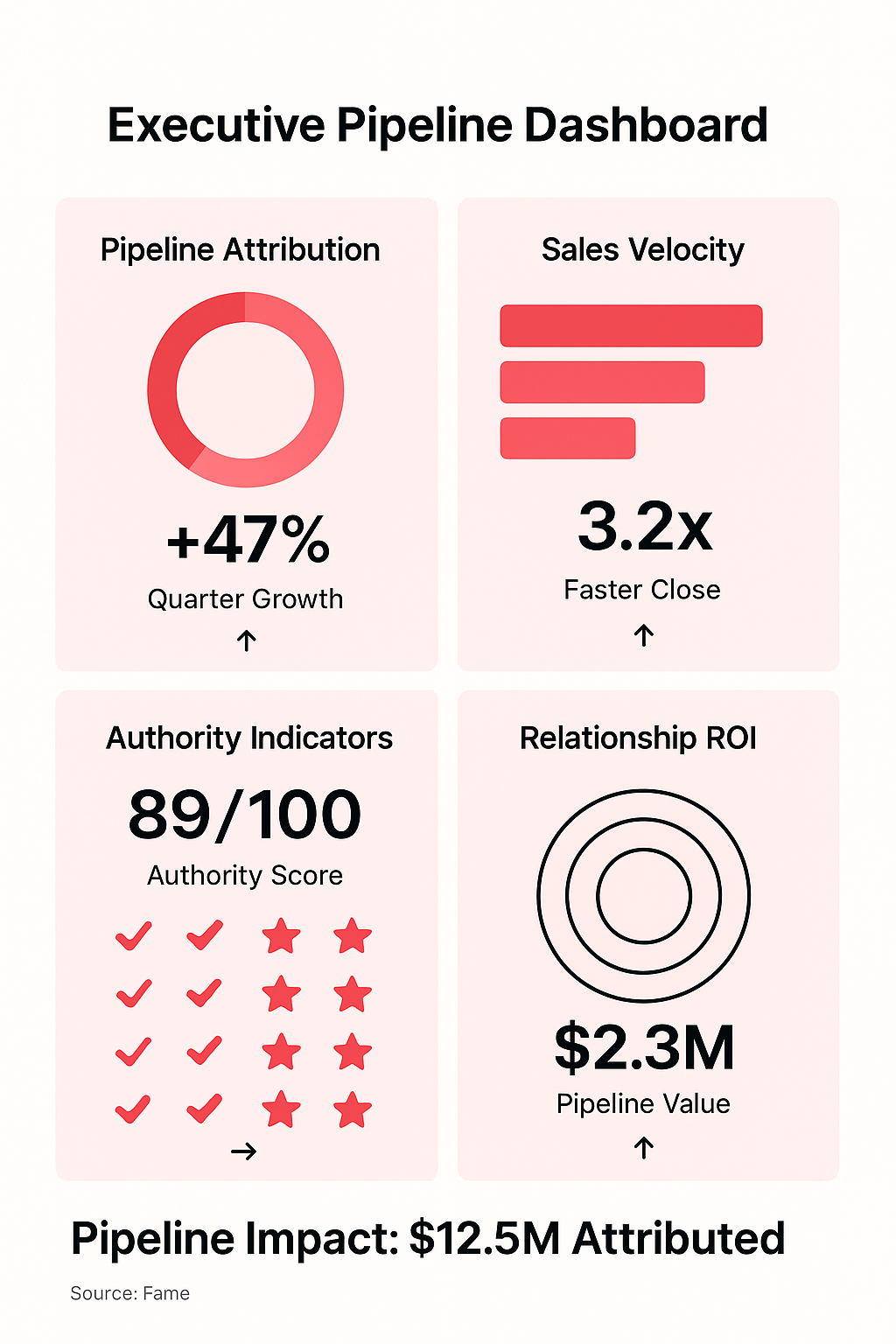
Pipeline Impact Dashboard Callout
Fame's approach to profitability measurement is refreshingly practical. They distinguish between "guest side profitable" (relationships with strategic guests who become customers) and "listener side profitable" (audience members who convert). While long-term listener profitability is the goal, guest-side profitability can drive immediate ROI within 6 months, crucial for maintaining CFO support during the growth phase.
Transition to Fame Difference
The real measurement breakthrough happens when you stop asking "How many people listened?" and start tracking "Which decision-makers took action?" Your B2B podcast strategy succeeds when prospects reference your insights in vendor evaluations, not when your hosting platform sends congratulatory download milestone emails.
As Fame's data confirms, 75% of listeners change brand perception after listening to a podcast. But perception without a pipeline is just expensive brand building. The companies winning with B2B podcasts track both the soft metrics of authority and the hard metrics of revenue, because in B2B, trust without transactions is just another failed content experiment.
The Fame Difference: Why Our B2B Podcasting Company Wins Where Others Don't
Unique Market Position
Fame isn't just another B2B podcasting company churning out generic interview shows. We're the only agency that guarantees pipeline impact because we built our methodology by launching 100+ revenue-driving podcasts for B2B companies. While others focus on downloads and production quality, we obsess over one metric: how much revenue your podcast generates. This B2B podcast strategy difference shows in every client engagement.
Differentiators
- ROI-First Methodology: Every decision, from guest selection to distribution strategy, maps back to pipeline impact. We don't celebrate download milestones; we celebrate closed deals influenced by podcast relationships. Our clients see 20-30% of new pipeline sourced through podcast touchpoints within 12 months.
- Operator-Led Approach: Built by B2B marketers who've actually driven revenue, not just created content. We've been in your shoes, fighting for budget approval and proving content ROI. This experience shapes every framework we deploy.
- End-to-End Execution: From strategic positioning through pipeline measurement, we handle the entire podcast lifecycle. No handoffs, no gaps, no excuses. Your podcast becomes a seamless extension of your demand generation engine.
- Proven Results: 100+ B2B podcasts launched, millions in attributed pipeline, and a methodology refined through real-world application. Our data-backed approach transforms podcasts from cost centers into profit centers.
Client Success Metrics & Testimonial Callout
Our clients don't just launch podcasts, they launch revenue engines. One SaaS company generated $890K in pipeline from 12 episodes. A cybersecurity firm shortened sales cycles by 31% through strategic podcast content. These aren't outliers; they're the standard when you apply Fame's methodology.
Transition to Final Section
The difference between Fame and other agencies isn't just experience, it's philosophy. We believe B2B podcasts should drive business outcomes, not just brand awareness. Ready to transform your content strategy into a revenue strategy?
Transform Your Podcast From Cost Center to Revenue Engine
Most B2B podcasts measure success in downloads. The smart ones measure it in the pipeline.
The difference isn't production quality or guest caliber, it's strategic intent. When you engineer every episode to accelerate trust with your exact buyers, podcasts transform from content expenses into revenue multipliers.
Fame's methodology proves this transformation is repeatable. Our clients consistently see 20-30% of new pipeline influenced by podcast touchpoints, with deals closing 31% faster and at 22% higher ACVs. This isn't luck, it's the result of treating your podcast as a strategic revenue channel, not a brand exercise.
Ready to build a B2B podcast that doubles as a revenue engine? Stop recording random conversations and start engineering market authority that converts. Get your proposal
FAQs
Why should we prioritize niche authority over broad awareness in our B2B podcast strategy?
Niche authority compounds, broad awareness evaporates. Data shows podcasts with tightly defined ICPs drive up to 3x more qualified inbounds and shift buyer trust by a 4:1 margin versus generalist shows. In crowded markets, being the only specialist in your segment beats being another voice in the noise.
What's the core framework for launching a podcast that actually moves the pipeline, not just brand awareness?
Start with a ruthless ICP definition and commercial outcomes, not content ideas. Fame's six-phase framework, ICP, POV, guest mapping, trust-building content, multi-channel amplification, and pipeline attribution, delivers a measurable pipeline within 90 days and compounds authority quarterly. Skip this, and you're just burning budget on vanity metrics.
How do we select and own a niche that delivers defensible market authority and revenue?
Own a niche where your solution solves urgent, expensive problems for a clearly defined buyer, ideally, one that your competitors can't credibly claim. Validate your niche by pain intensity (7+/10), low competitive saturation (≤3 direct shows), and at least 70% overlap with your commercial value props. If you can't dominate the space for 18 months, pivot tighter.
What's the real business impact of strategic guest selection versus chasing big-name influencers?
Pipeline-driven guest selection turns your show into a revenue engine, and 25–40% of targeted guests progress to sales conversations or referrals within 90 days. Forget vanity guests; prioritize those with budget authority, ICP overlap, and real-world insights. One client closed $420K in enterprise deals from podcast guest relationships alone.
Which podcast content formats actually build trust and drive qualified leads, not just downloads?
Operator-led interviews, deep-dive episodes, and tactical roundtables outperform generic interviews by turning expertise into actionable value. Deep-dive episodes alone generate 40% more sales enablement assets and 3x more qualified leads than entertainment-first formats. If your format doesn't build trust and pipeline, it's just noise.
How do we amplify podcast reach and ensure episodes drive measurable pipeline, not just vanity downloads?
Deploy a four-pillar distribution engine: dark social (targeted Slack/LinkedIn groups), sales team activation (CRM-integrated clips), SEO-optimized show notes, and hyper-targeted paid LinkedIn. Fame clients see 340% reach growth and 4x lead generation within 90 days, because distribution, not publishing, drives pipeline.
How do we measure ROI and authority impact from our podcast investment?
Track pipeline attribution, sales velocity, authority signals (analyst mentions, speaking invites), and guest relationship value, not downloads. Expect 20–30% of new pipeline to be sourced or influenced by podcast touchpoints in 6–12 months, with podcast-influenced deals closing 31% faster and at 22% higher ACVs. If you're not measuring business outcomes, you're not measuring what matters.

